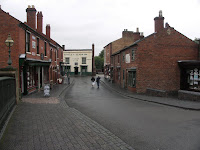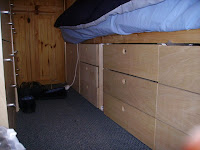Last Sunday, 22nd February, I went to the National Boat Caravan and Outdoor Show at the National Exhibition Centre Birmingham. I drove to Rugby and got the train to Birmingham International station. The station is a short indoor walk away from the NEC and the cost of the train £6.40 and parking at Rugby £6.00 was about the same as I would have spent on petrol to drive all the way.
One hall was filled with motor caravans. Its amazing how they can pack them in so closely, but they have no interest for me.

The interesting stuff was on the small stands located around the walls. There were two stands demonstrating Fein tools. My Fein Multimaster does things that are just impossible otherwise - especially cutting access holes in awkward places without taking everything apart. The one in the picture has a sander attached. But the saws, like the one on the left, are really cool. Apart from some food the only thing I bought at the show was a new blade - like the one on the left!
There were a few narrowboats on show as well as a couple of widebeam boats. When you think of the size of narrowboats "a few" take up a lot of space. I was interested to see how the woodwork details were done, such as edges of panels, doors and shelves. Much of it is quite simple but carefully and evenly executed.
The other thing I wanted to look at was mobile homes. Somewhere in the back of m

y mind is the idea of buying one as a fixed base. However as I think about it now, the rationale may be less clear cut from my new base on a narrowboat as compared with when I was living on "Orange". I deliberately went in search of the cheapest one and I was amazed at what you get for £18,000. Ok this was a two bedroom version and a third bedroom would be a useful study or workshop for an extra £1,000. Why do people spend huge amounts on regular houses? Yes I know that the price of a house includes the site, and you would expect a house to last longer. But even if you bought a site I suspect you would still have money for a few mobile homes. And why are we paying now for benefits for future generations?
It’s interesting how mobile home parks at holiday resorts are solid well kept middle class enclaves. Whereas if I developed a field in, say, Maynooth as a mobile home park for affordable homes the general assumption is that it would become a dirty unkempt ghetto for the poor. Perhaps most of the attraction of expensive houses is the price rather than the accommodation, because the price excludes poor people. (Poor being universally defined as everyone who can afford less than me!)
There was a wonderful array of men demonstrating miracle products at the show. I have to confess to being impressed with a steam floor cleaner that seemed to clean with very little water. One has to remind oneself that it might just have been cleaning the things it is good at cleaning. There was another demonstration of a brush with rubber bristles that seemed miraculously to sweep hair and broken cornflakes out of a carpet. Another man was demonstrating cobalt tipped drills (or at least the good one he had in his drill) that had a lifetime guarantee. He was selling a box of assorted sizes for £40. I suspect I will have plenty of use for good drills, but £40 seemed too much of a gamble. I could see no sign of the manufacturers name or even a "respectable looking" business name that might lead you to think the guarantee would be honoured in 5 months time, never mind 5 years. On the other hand we all put our blind faith in the pin stripe suited and expensively logoed banks ...
 picture) were moved brick by brick from other locations and rebuilt in the museum. But the whole thing has been done so well that I still find it hard to believe. It would have been a wonderful achievement if they had just reconstructed the facades of the various houses and shops so that you could go into the front rooms.
picture) were moved brick by brick from other locations and rebuilt in the museum. But the whole thing has been done so well that I still find it hard to believe. It would have been a wonderful achievement if they had just reconstructed the facades of the various houses and shops so that you could go into the front rooms. including the typical junk that collects over many years. And, when you realize that there is nobody actually working in the buildings and sheds to create the junk, the naturalness of the whole thing is magnificent.
including the typical junk that collects over many years. And, when you realize that there is nobody actually working in the buildings and sheds to create the junk, the naturalness of the whole thing is magnificent. building in its original location. When it was rebuilt the image was still there and has not been painted.
building in its original location. When it was rebuilt the image was still there and has not been painted.













































